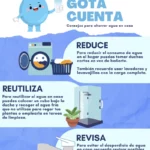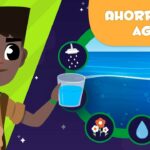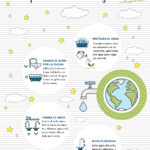
1. Why Should You Save Water?
💧 Water is a precious resource that is essential for all living beings on Earth. However, we often take it for granted and overlook the significance of conserving water. In this article, we will explore the importance of saving water and why it should be a top priority for everyone.
🌍 One of the main reasons why we should save water is to preserve our planet’s natural resources. Water scarcity is a growing concern in many parts of the world, and if we continue to be careless with our water consumption, we risk depleting this vital resource. By saving water, we ensure that future generations will have access to clean and safe water.
💰 Another compelling reason to save water is to reduce our utility bills. Many people are unaware of the amount of water they waste on a daily basis. By implementing simple water-saving habits, such as fixing leaky faucets and using more efficient appliances, we can significantly cut down our water consumption and save money in the process.
🌿 Conserving water also has a direct impact on the environment. Water treatment and delivery require energy, and by reducing our water usage, we can help reduce carbon emissions and alleviate the strain on natural ecosystems. Additionally, saving water helps preserve habitats, as some wildlife species heavily rely on specific water sources for their survival.
In conclusion, the importance of saving water cannot be overstated. It is crucial for the well-being of our planet, our finances, and the preservation of our environment. By being mindful of our water usage and implementing water-saving measures, we can make a positive difference and contribute to a more sustainable future. Let’s all take responsibility and do our part in conserving this invaluable resource. 💦
2. Understanding Water Usage
🚰 Water is a vital resource that we often take for granted. Understanding how we use water and the impact it has on our environment is crucial in promoting sustainability and responsible water management.
Water usage can be categorized into various sectors, including domestic, agricultural, industrial, and commercial. By gaining a better understanding of water usage in each sector, we can identify areas where conservation measures can be implemented to reduce waste and promote efficiency.
One important aspect of understanding water usage is knowing the difference between consumptive and non-consumptive water use. Consumptive water use refers to water that is not returned to its source after use, such as water used in agriculture that is lost to evaporation. Non-consumptive water use, on the other hand, is water that is returned to its source after use, such as water used in manufacturing processes.
By understanding the different types of water usage and their impacts, we can make informed decisions and take steps to reduce our water footprint. Implementing water-saving practices at home, recycling water in industrial processes, and promoting sustainable irrigation techniques in agriculture are just a few ways we can contribute to the conservation of this precious resource.
3. Easy Ways to Save Water at Home
💧As the world continues to face water scarcity, it becomes increasingly important for individuals to take responsibility for conserving water. In this article, we will explore three easy ways to save water at home and contribute to the sustainability of our planet.
💧One simple but effective way to reduce water consumption is by fixing any leaks in your home. Leaking faucets, toilets, or pipes can waste hundreds of gallons of water each month. Regularly check for leaks and repair them promptly to prevent unnecessary water loss.
💧Another way to save water is by installing low-flow fixtures in your home. These fixtures are designed to reduce the water flow without compromising functionality. By using low-flow showerheads, faucets, and toilets, you can save gallons of water every day.
💧A habit that many of us have is leaving the tap running while we brush our teeth or wash dishes. This seemingly harmless act can waste a significant amount of water. Make it a habit to turn off the tap when not in use, whether you’re lathering up, scrubbing, or rinsing. This simple change can make a big difference.
💧One of the easiest ways to conserve water is by collecting rainwater. Install a rain barrel in your backyard to collect rainwater, which can then be used for watering plants or washing your car. Rainwater is free and abundant, so why not take advantage of it?
💧Lastly, be mindful of the time you spend in the shower. Taking shorter showers can save a substantial amount of water. Try to limit your showers to five minutes or less. You can also turn off the water while soaping up or scrubbing your hair, then switch it back on to rinse off.
By implementing these easy ways to save water at home, you can make a positive impact on the environment while also reducing your water bills. Remember, every drop counts! Let’s work together to preserve this precious resource for future generations. 💦
- 🔋 Ahorrar batería en Samsung Watch 6: ¿Cómo prolongar la vida de tu smartwatch?
- 💡✨ Ahorrar energía radiador: Descubre métodos eficientes para optimizar el consumo energético y reducir la factura
- 💰 Descubre 10 😲 Maneras Geniales de Ahorrar Dinero
- 🔥💡 Ahorrar energía con calefacción: ¡Descubre los mejores consejos para maximizar tus ahorros y cuidar el medio ambiente!
- 🔋¡Descubre los mejores consejos para ahorrar batería en Android!📱
4. Efficient Water-Saving Devices
💧 Did you know that there are efficient water-saving devices available that can help you conserve water significantly? These devices are designed to reduce water usage without compromising on performance. In this section, let’s explore some of the top water-saving devices that you can consider for your home.
🚿 One of the essential water-saving devices is a high-efficiency showerhead. These showerheads are designed to minimize water flow while maintaining a pleasing shower experience. By using a high-efficiency showerhead, you can save gallons of water per minute, which can translate to significant water and energy savings over time.
🚽 Another device that can help conserve water is a dual-flush toilet. Traditional toilets use a standard flush that consumes a significant amount of water every time. However, dual-flush toilets allow you to choose between a low-volume flush for liquid waste or a high-volume flush for solid waste. This flexibility helps reduce water consumption and benefits both the environment and your water bill.
🌿 To further enhance your water-saving efforts, consider installing faucet aerators. These small devices can be attached to your faucets and reduce the flow of water without compromising water pressure. Faucet aerators mix air with the water, resulting in a steady stream while consuming less water overall.
🌊 If you have a garden or outdoor area, a smart irrigation system can be a game-changer. These systems use weather data and sensors to ensure that your plants and lawn receive the right amount of water at the right time. By avoiding overwatering, which is a common issue with traditional sprinklers, smart irrigation systems can help save a significant amount of water.
🌙 Additionally, consider installing a rainwater harvesting system. These systems collect rainwater from your roof or gutters and store it for later use, such as watering plants or washing cars. By utilizing rainwater, you can reduce your reliance on freshwater sources and contribute to water conservation efforts.
🔧 Lastly, consider replacing old, inefficient appliances, such as washing machines and dishwashers, with water-efficient models. Newer appliances are designed to use less water while providing optimal performance. By making this switch, you can contribute to water conservation and potentially lower your water bills in the long run.
5. Landscaping Techniques for Water Conservation
🌿💧
When it comes to water conservation, implementing effective landscaping techniques can make a significant difference. By making mindful choices in your outdoor spaces, you can not only reduce water consumption but also create a beautiful and sustainable environment. In this article, we will explore five landscaping techniques that can help conserve water and promote eco-friendly practices.
One of the first steps in water conservation through landscaping is to choose native plants. Native plants are adapted to the local climate and require less watering than non-native species. By incorporating these plants into your landscape, you can minimize water usage while still enjoying a vibrant and diverse garden.
Another effective technique is the use of drip irrigation systems. Drip irrigation delivers water directly to the plant’s root zone, minimizing water loss due to evaporation. This method is much more efficient than traditional sprinkler systems, ensuring that every drop counts and reducing water wastage.
Mulching is another essential practice for water conservation. By adding a layer of mulch around plants and in garden beds, you can significantly reduce evaporation, retain soil moisture, and suppress weed growth. This simple step can make a big difference in minimizing water loss and maintaining healthy plants.
Incorporating water-saving features, such as rain barrels or cisterns, is an excellent way to conserve water. These systems collect rainwater from rooftops, which can then be used for watering plants and other outdoor needs. By utilizing this free and abundant resource, you can reduce reliance on treated water and contribute to water conservation efforts.
Lastly, xeriscaping is a landscaping technique specifically designed to minimize water usage. Xeriscaping involves selecting drought-tolerant plants, efficient irrigation systems, and strategic design choices that promote water efficiency. By embracing xeriscaping principles, you can create a stunning landscape that requires minimal water while still thriving in challenging conditions.
By implementing these landscaping techniques for water conservation, you can play a significant role in preserving this precious resource. Whether you are a homeowner or a professional landscaper, making conscious choices in your outdoor spaces can help create a more sustainable and water-conscious environment. Let’s come together to protect our planet’s most valuable asset – water. 🌍🌱💧
6. Water-Saving Habits for Children
✨ Being environmentally conscious is an essential lesson we should teach our children from an early age. One crucial aspect of sustainability is water conservation. 💧 In this blog post, we will explore six water-saving habits that children can easily adopt and incorporate into their daily routine.
💦 First and foremost, children can limit their shower time. Encourage them to take shorter showers, ensuring they turn off the water while soaping up or brushing their teeth. Teaching them the value of not wasting water will help them understand the importance of conserving this precious resource.
💦 Secondly, children should be reminded to turn off the faucet tightly after use. A dripping faucet can waste a surprising amount of water over time. By emphasizing the importance of checking for leaks and turning off the faucet completely, children can actively contribute to water conservation efforts.
💦 Additionally, children can learn to reuse water whenever possible. For instance, after washing fruits or vegetables, encourage them to collect the water in a container and use it for watering plants or cleaning chores. Reinforcing this practice will instill a sense of responsibility in children towards using water wisely.
💦 Finally, involving children in gardening activities can provide an excellent opportunity to teach them about the importance of watering plants efficiently. Help them understand the specific needs of different plants and encourage them to water during appropriate times of the day, preferably early morning or late evening, to minimize water loss due to evaporation.
By instilling these six water-saving habits in children, we can develop a generation that values and prioritizes sustainable living. Let’s empower our children to play an active role in conserving water, ensuring a brighter and greener future for all. 💚💦
7. Inspiring Success Stories
💫
En este artículo, quiero compartir contigo algunas historias inspiradoras de éxito que te motivarán a perseguir tus objetivos con determinación y pasión. Estas historias demuestran cómo personas comunes como tú y yo han logrado superar obstáculos y alcanzar el éxito en diferentes áreas de sus vidas.
💼
Una de estas historias de éxito es la de Steve Jobs, cofundador de Apple. A pesar de enfrentar muchos desafíos en su vida, incluyendo ser despedido de su propia empresa, Jobs nunca perdió la fe en su visión y continuó innovando. Su determinación lo llevó a revolucionar la industria de la tecnología y convertirse en un líder inspirador para muchos emprendedores.
📚
Otra historia inspiradora es la de J.K. Rowling, la autora de la famosa saga de Harry Potter. Rowling pasó por momentos difíciles antes de que su libro fuera publicado, enfrentando rechazos constantes de editoriales. Sin embargo, su persistencia y creencia en su historia la llevaron a convertirse en una de las autoras más exitosas de todos los tiempos.
🌍
El empresario Elon Musk es también una fuente de inspiración. Con su visión de cambiar el mundo a través de la energía sostenible y la exploración espacial, Musk ha fundado varias compañías exitosas como Tesla y SpaceX. A pesar de los constantes desafíos y críticas, su pasión y determinación lo han llevado a alcanzar grandes éxitos en múltiples industrias.
🏆
La historia de Michael Jordan es otro ejemplo de éxito inspirador. Considerado uno de los mejores jugadores de baloncesto de todos los tiempos, Jordan enfrentó muchas dificultades y fracasos antes de alcanzar la grandeza. Sin embargo, su ética de trabajo, su determinación y su mentalidad ganadora lo convirtieron en una leyenda del deporte y un modelo a seguir para muchos.
Estas historias inspiradoras nos recuerdan que, si persistimos en nuestros sueños y trabajamos arduamente, podemos superar cualquier obstáculo y lograr el éxito. Tener modelos a seguir y aprender de sus experiencias puede ser una fuente invaluable de motivación e inspiración para alcanzar nuestras metas y objetivos en la vida. 🌟
 🚰💧 ¡Ahorra agua cada gota cuenta! Descubre los mejores consejos para ser más sustentable en casa
🚰💧 ¡Ahorra agua cada gota cuenta! Descubre los mejores consejos para ser más sustentable en casa 🌊💧¡Ahorrar agua con dibujos animados! Descubre cómo enseñar a los niños sobre la importancia de cuidar el agua en un mundo divertido y educativo. 🎉🖍️
🌊💧¡Ahorrar agua con dibujos animados! Descubre cómo enseñar a los niños sobre la importancia de cuidar el agua en un mundo divertido y educativo. 🎉🖍️ 🚿💧 Ahorrar agua en el baño: consejos sencillos para ser más eco-friendly en tu rutina diaria
🚿💧 Ahorrar agua en el baño: consejos sencillos para ser más eco-friendly en tu rutina diaria 💧 Los mejores ejemplos para 💦 ahorrar agua y cuidar nuestro planeta
💧 Los mejores ejemplos para 💦 ahorrar agua y cuidar nuestro planeta 💧🏠 Ahorrar agua en el hogar: consejos prácticos para hacerlo de manera eficiente
💧🏠 Ahorrar agua en el hogar: consejos prácticos para hacerlo de manera eficiente 💧🌍 ¡Sencillos consejos para ahorrar agua en el trabajo y cuidar el planeta!
💧🌍 ¡Sencillos consejos para ahorrar agua en el trabajo y cuidar el planeta! 💧🌍 ¡Aprende cómo ahorrar agua potable y cuidar el planeta al mismo tiempo!
💧🌍 ¡Aprende cómo ahorrar agua potable y cuidar el planeta al mismo tiempo! 💧💡 Proyecto de Ahorro de Agua: ¡Descubre cómo reducir tu consumo y contribuir al cuidado del planeta!
💧💡 Proyecto de Ahorro de Agua: ¡Descubre cómo reducir tu consumo y contribuir al cuidado del planeta! 💧 Ahorrar agua: todo lo que necesitas saber según Wikipedia
💧 Ahorrar agua: todo lo que necesitas saber según Wikipedia